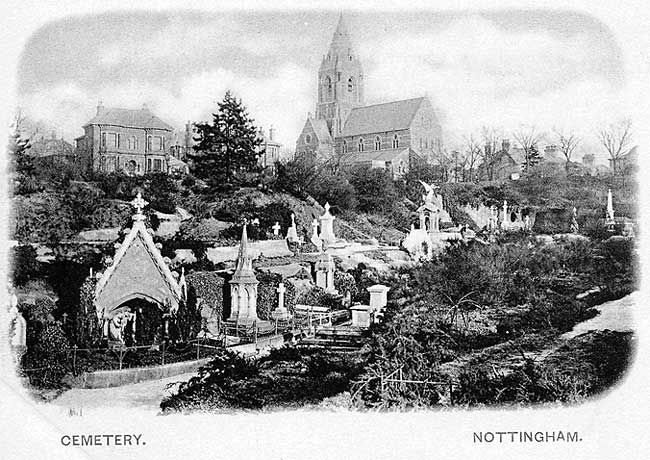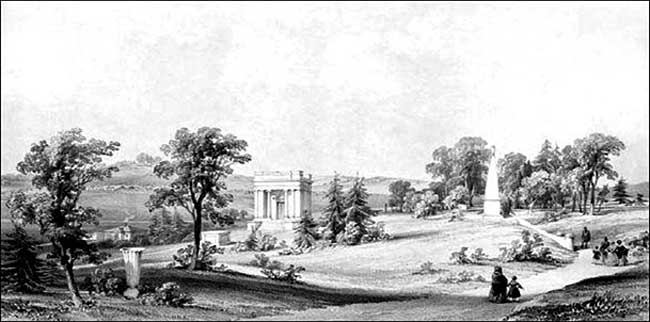Articles from the Thoroton Society Newsletter
A Place to Rest
By Kevin Powell
 Postcard Private Collection
Postcard Private Collection On the afternoon of the 11th October 1831 a large group of people gathered in the Market Place in Nottingham and were confronted by the Nottingham Militia. This was the final stand of the Nottingham Reform Rioters, who on the same day had destroyed William Lowe's Silk Mill at Beeston and Nottingham Castle, the evening before.
Suddenly, a musket was fired, the ball from that musket struck Thomas Auckland in the shoulder, the musket ball passed through him and struck the side of a man's head who was standing behind.
The Nottingham Review, when they wrote about the event described Thomas Auckland as a 'tailor' and a 'Hero of Waterloo'. It is this latter statement that makes the story more interesting, the fact that this man had fought and survived the Battle of Waterloo and come home, yet here he was in his home town and was shot. Thankfully he survived. A 'Hero of Waterloo' - this is this type of statement or small snippet which also makes reading some of the graves in the General Cemetery and the Church Cemetery more interesting.
Often a headstone will say 'Sacred to the Memory of……’ or `In Remembrance of……’ or similar words. But sometimes it will give us a snippet to indicate who the person was.
People like: William Frederick Wallet, 'the Queen’s Jester', David Musson Jackson, Twenty Nine years Governor of the Gaol and House of Correction (in Nottingham), Philip Myers, Founder of the Bathing Establishment in Pelham Street, George Madin, and Sergeant in the 33rd Regiment of Foot (Wellington's Own). He served in the action of Quatre Bras and Waterloo.
It is these little extras that draw people to explore cemeteries and then want to learn more about our own historic cemeteries here in Nottingham and those who are buried there.
Cemeteries are not morbid places full of dead people, but a unique glimpse into the past and the people who were part of Nottingham’s history and in some cases our nation's history.
Nottingham has three historic cemeteries, Basford, the General Cemetery and the Church Cemetery or, as it is locally known, the ‘Rock Cemetery’. Two of these are located within easy reach the City centre.
Both the General Cemetery and the Church Cemetery were conceived out of necessity due to the population explosion that occurred in Nottingham in the first half of the 19th century.
The town population nearly doubled from nearly 29,000 in 1801 to 57,000 by 1851, due to people coming to the new industrial towns like Nottingham from the rural areas.
Nottingham’s problem was that the town’s boundaries did not expand to cope with the ever increasing numbers. Burgesses and landowners would not give up the land they owned, therefore the town’s population was confined to virtually the same area as it had been in medieval times.
To put it in context – in the mid1800s, 50,000 people lived where 10,000 had lived 100 years before. Much of the housing consisted of 3 to 4 storey, back to back houses set around courts and alleyways. Many houses were overcrowded with poor sanitation. Water was often drawn from a hand pump in the yard. When disease broke out, death was not too far behind. The cholera outbreak of 1832 and 1833 would see over 800 people affected and 300 would die.
Burial of the dead became a problem, as the town’s cemeteries were filling up and there was a desperate need to find another place to bury the dead.
In 1836, the Trustees of the General Cemetery Company purchased land adjacent to Sion Hill, which we now refer to as Canning Circus. Initially, twelve acres of land were purchased for the sum of £6,000 with the intention of creating a ‘Church of England’ cemetery. However, by 1865, the area had increased to 20 acres to accommodate ‘non-conformists’ and ‘dissenters’. Once the cemetery was completed and consecrated, the first interment took place on the 9th February 1837.
The concept for the Church Cemetery came about in June 1850, after land had been set aside for a new cemetery in Nottingham, in the 1845 Enclosure Act.
The Act created 130 acres of land to be used for public recreation. Initially, the area set aside for the cemetery was a former sand mine and quarry. The cemetery was to consist of four acres; however, once the Church Cemetery Company was formed in April 1851, the Company added a further nine acres to the site making a total of thirteen acres.
The cemetery’s proposed layout was overseen by Edwin Patchitt, a local solicitor and clerk to the Church Cemetery Company. He used the former mines’ unique features to create the cemetery we see today. Once the new cemetery was completed, it was consecrated and officially opened on the 18th June 1856, and the first burial took place two days later.
Both cemeteries continued to flourish as they passed into the 20th century; however by 1923, the General Cemetery Company was found to have broken Home Office guidelines for the burial of the dead and by 1927, the cemetery was officially closed by Act of Parliament.
Following the Second World War, the company was declared bankrupt and ownership of the cemetery passed to the Crown. Eventually the ownership of the cemetery would pass to the City Council in 1956.
Ownership of the Church (Rock) Cemetery would also pass to the Council in the early 1960s.
By the time the Council had taken over cemeteries, the mortuary chapels on each site had fallen into a serious state of disrepair and the Council took the decision to demolish them.
As you walk around the cemeteries today, it is hard to imagine that there are 150,000 bodies buried in the General Cemetery and 43,000 in the Church (Rock) Cemetery. The cemeteries are now maintained by Nottingham City Council’s Parks and Open Spaces Department and have become a sanctuary for flora and fauna. As you walk and stroll around them today, they are truly a…..
‘Place to Rest ……. In Peace’.
 General Cemetery image thanks to the Local Studies Library
General Cemetery image thanks to the Local Studies Library< Previous